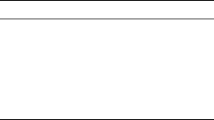Abstract
Robust Statistics considers the quality of statistical decisions in the presence of deviations from the ideal model, where deviations are modelled by neighborhoods of a certain size about the ideal model. We introduce a new concept of optimality (radius-minimaxity) if this size or radius is not precisely known: for this notion, we determine the increase of the maximum risk over the minimax risk in the case that the optimally robust estimator for the false neighborhood radius is used. The maximum increase of the relative risk is minimized in the case that the radius is known only to belong to some interval [r l ,r u ]. We pursue this minmax approach for a number of ideal models and a variety of neighborhoods. Also, the effect of increasing parameter dimension is studied for these models. The minimax increase of relative risk in case the radius is completely unknown, compared with that of the most robust procedure, is 18.1% versus 57.1% and 50.5% versus 172.1% for one-dimensional location and scale, respectively, and less than 1/3 in other typical contamination models. In most models considered so far, the radius needs to be specified only up to a factor \(\rho\le \frac{1}{3}\), in order to keep the increase of relative risk below 12.5%, provided that the radius–minimax robust estimator is employed. The least favorable radii leading to the radius–minimax estimators turn out small: 5–6% contamination, at sample size 100.
Similar content being viewed by others
References
Andrews DF, Bickel PJ, Hampel FR, Huber PJ, Rogers WH, Tukey JW (1972) Robust estimates of location: survey and advances. Princeton University Press, Princeton
Beran RJ (1976) Adaptive estimates for autoregressive processes. Ann Inst Stat Math 11:432–452
Beran RJ (1981) Efficient robust estimates in parametric models. Z Wahrsch verw Gebiete 55: 91–108
Bickel PJ (1981) Quelques aspects de la statistique robuste. In: Hennequin PL (ed) Ecole d’Eté de Probabilités de Saint Flour IX 1979, lecture notes in mathematics, vol 876. Springer, Berlin, pp 1–72
Bickel PJ (1982) On adaptive estimation. Ann Stat 10:647–671
Bickel PJ (1984) Robust regression based on infinitesimal neighborhoods. Ann Stat 12:1349–1368
Huber PJ (1964) Robust estimation of a location parameter. Ann Math Stat 35:73–101
Huber PJ (1981) Robust statistics. Wiley, New York
Huber PJ (1983) Minimax aspects of bounded influence regression. J Am Stat Assoc 78:66–80
Huber PJ (1996) Robust statistical procedures (2nd edn). In: CBMS-NSF regional conference series in applied mathematics, vol 68. Soc Industr Appl Math, Philadelphia, Pennsylvania
Klaassen C (1980) Statistical performance of location estimators. In: Mathematical centre tract, vol 133. Mathematisch Centrum, Amsterdam
Kohl M (2005) Numerical contributions to the asymptotic theory of robustness. Dissertation, Universität Bayreuth. Also available under http://www.stamats.de/ThesisMKohl.pdf
Kreiss J-P (1987) On adaptive estimation in stationary ARMA processes. Ann Stat 15:112–133
Millar PW (1981) Robust estimation via minimum distance methods. Z Wahrsch Verwandte Geb 55:73–89
Pfanzagl J, Wefelmeyer W (1982) Contributions to a general asymptotic statistical theory. In: Lecture notes in statistics, vol 13. Springer, Berlin
R Development Core Team (2005) R: a language and environment for statistical computing. R Foundation for Statistical Computing, Vienna, Austria. ISBN 3-900051-07-0; http://www. R-project.org
Rieder H (1994) Robust asymptotic statistics. Springer, New York
Rieder H (2000) Neighborhoods as nuisance parameters? Robustness vs. semiparametrics. Math Methods Stat (submitted)
Rieder H (2001) Nonuniform convergence of adaptive estimators in linear time series models (Manuscript)
Ruckdeschel P (2001) Ansätze zur Robustifizierung des Kalman–Filters. Dissertation, Universität Bayreuth
Ruckdeschel P, Rieder H (2004) Optimal influence curves for general loss functions. Stat Decis 22:201–223
Witting H, Müller–Funk U (1995) Mathematische Statistik II. B.G. Teubner, Stuttgart
Author information
Authors and Affiliations
Corresponding author
Rights and permissions
About this article
Cite this article
Rieder, H., Kohl, M. & Ruckdeschel, P. The cost of not knowing the radius. Stat. Meth. & Appl. 17, 13–40 (2008). https://doi.org/10.1007/s10260-007-0047-7
Accepted:
Published:
Issue Date:
DOI: https://doi.org/10.1007/s10260-007-0047-7
Keywords
- Symmetric location and contamination
- Infinitesimal asymmetric neighborhoods
- Total variation, contamination
- Asymptotically linear estimators
- Influence curves
- Maximum asymptotic variance and mean square error
- Relative risk
- Inefficiency
- Least favorable radius
- Radius–minimax robust estimator
- Location, scale, regression models




